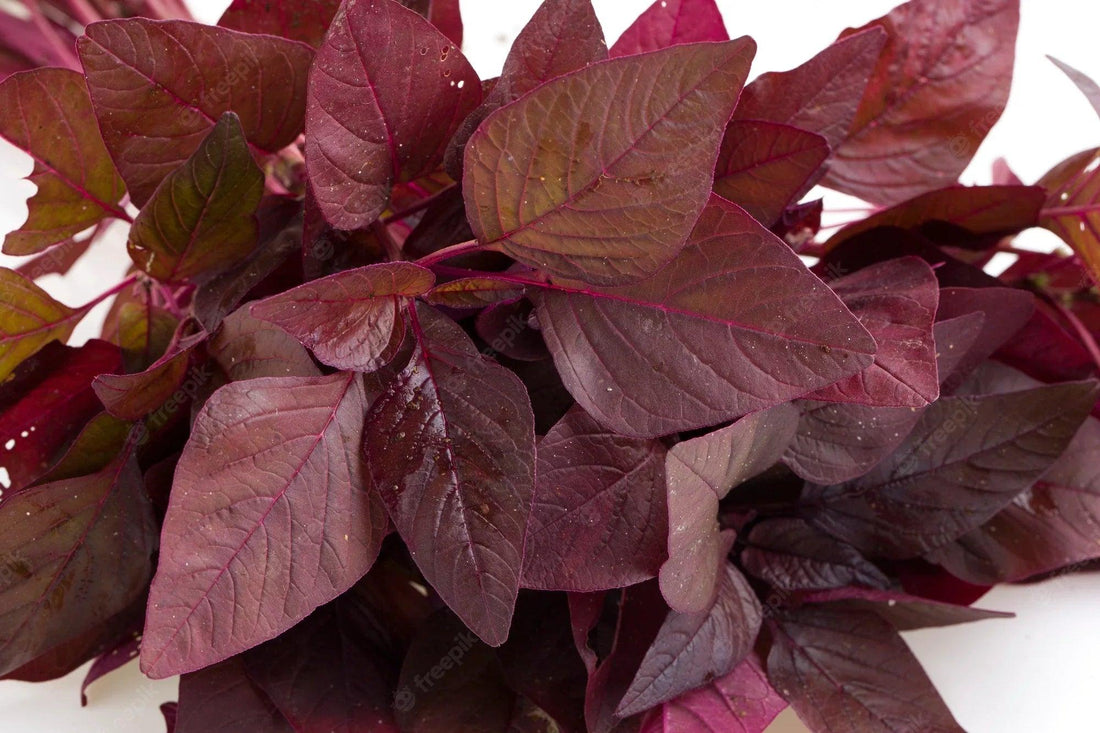Introduction

Red amaranth (Amaranthus cruentus) is one of the most rewarding crops you can grow at home. Known for its striking red leaves and seed heads, this red amaranth plant is not only beautiful but also highly nutritious. Once cultivated by the ancient Aztecs, amaranth plants were valued for their protein-rich amaranth seeds and tender, spinach-like leaves — often called Chinese spinach.
Whether you’re a beginner gardener or experienced grower, learning how to grow red amaranth is easy. This warm-season crop thrives in full sun, adapts to most soil types, and produces abundant leaves and seeds you can enjoy all season long.
What Makes Red Amaranth Special
Red amaranth combines ornamental beauty with practical value. The tall plants feature flower heads in shades of crimson or burgundy, making them a striking ornamental plant or cut flower in any garden. As the plants grow, they produce nutrient-rich greens that are excellent for stir-fries, soups, and salads.
The red amaranth seeds develop in dense seed heads that can be harvested for amaranth grains — small, round, and packed with protein. This dual-purpose nature makes amaranth one of the most easy to grow and versatile crops for home gardeners.

Planting Amaranth: From Seeds to Seedlings
When and Where to Plant
The best time for planting amaranth is after the danger of frost has passed. Choose a sunny location with well-drained soil. To determine the ideal planting window for your area, check your USDA growing zone.
Amaranth prefers full sun and thrives in soil with a neutral pH. If you’re unsure about your soil’s acidity, see our guide on understanding soil pH.
How to Plant Red Amaranth Seeds
You can grow red amaranth from seed directly in the garden or start seeds indoors. For direct sowing, scatter red amaranth seeds thinly across the soil surface and lightly cover them with about ¼ inch of soil. Keep the area evenly moist until germination, which usually takes 7–10 days.
If you prefer to start early, you can also start red amaranth seeds indoors and transplant them once the weather warms. For small-space gardeners, red amaranth also grows well in containers—perfect for urban gardening without a yard.

Growing Red Amaranth Successfully
Soil and Fertilizer Needs
Red amaranth is an easy to grow crop that does well in most soil types. For best results, amend your soil with compost before planting. Balanced nutrients help your amaranth plants develop strong roots and vibrant foliage.
For ongoing care, use a mild organic fertilizer. Learn how to choose the right one in our article on granular, pelleted, soluble, and liquid fertilizers.
Watering and Sunlight
Amaranth loves warmth and sunlight. Ensure it receives at least 6–8 hours of full sun daily. Keep the soil moist but not soggy, especially while plants are young. Once established, amaranth is quite drought-tolerant.
Use soaker hoses to water efficiently and reduce leaf moisture, which can help prevent fungal issues.
Thinning and Maintenance
When seedlings reach about 6 inches tall, thin them to 10–12 inches apart. Proper spacing allows your red amaranth plant to grow tall and healthy. Remove weeds regularly to prevent competition for nutrients and water.
Harvesting Red Amaranth

When to Harvest
Harvesting red amaranth depends on whether you’re growing it for greens or grains. For tender young leaves, harvest when the plants are about 10–12 inches tall. These highly nutritious leaves are best eaten fresh or lightly cooked.
If you’re growing for amaranth grains, wait until the flower heads mature and begin to dry. This is when they’re ready to harvest. Mature seed heads will turn brown or golden, and you’ll notice some black seed or tan-colored grains loosening naturally.
How to Harvest and Dry Seeds
Cut mature seed heads and place them in a paper bag. Hang them upside down in a warm, dry area for about a week. Once dry, gently rub the seed heads to release the amaranth seeds. Sift out any debris and store the cleaned seeds in an airtight container.
If you’re growing varieties like love lies bleeding or Hopi Red Dye, you’ll notice striking, cascading flower clusters that also produce abundant seeds. You can find these varieties at our amaranth seed collection or shop for Garnet Red Amaranth Greens Seeds and Hopi Red Dye Amaranth Flower Seeds.

Storage and Seed Saving
After harvesting amaranth, ensure seeds are completely dry before storing. Properly dried amaranth seeds can last several years when kept in a cool, dark place. Saving your own seeds ensures a sustainable supply for future planting seasons.
For next year’s garden, simply replant your saved red amaranth seeds in early spring once soil temperatures warm up. With proper care, your plants grow quickly and reward you with both nutritious greens and abundant seeds.
Conclusion
Growing red amaranth offers beauty, nutrition, and sustainability in one easy-to-grow plant. From seed to harvest, this vibrant crop rewards gardeners with colorful leaves, striking flower heads, and nutrient-packed amaranth grains.
Whether you’re cultivating amaranth for its edible greens, decorative blooms, or historical roots tied to the ancient Aztecs, it’s a valuable addition to any garden. Visit Grow Organic to explore more resources on how to grow popcorn and the best way to pop it or to purchase amaranth seeds for your next planting season.

